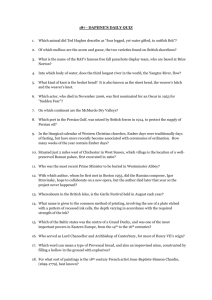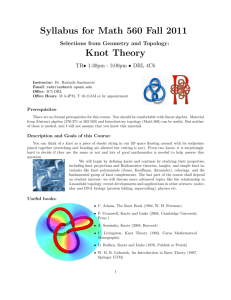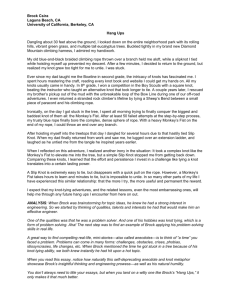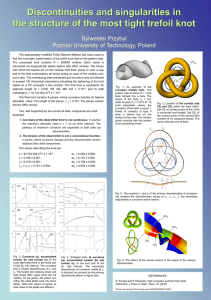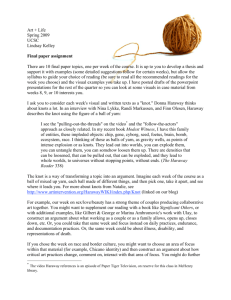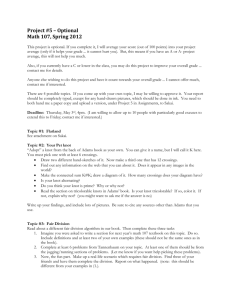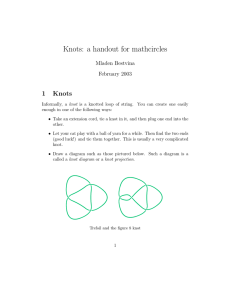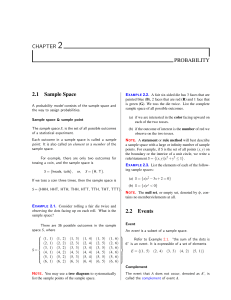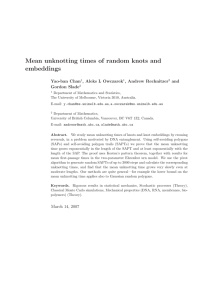Proving the Trefoil is Knotted William Kuszmaul, Rohil Prasad, Isaac Xia
advertisement
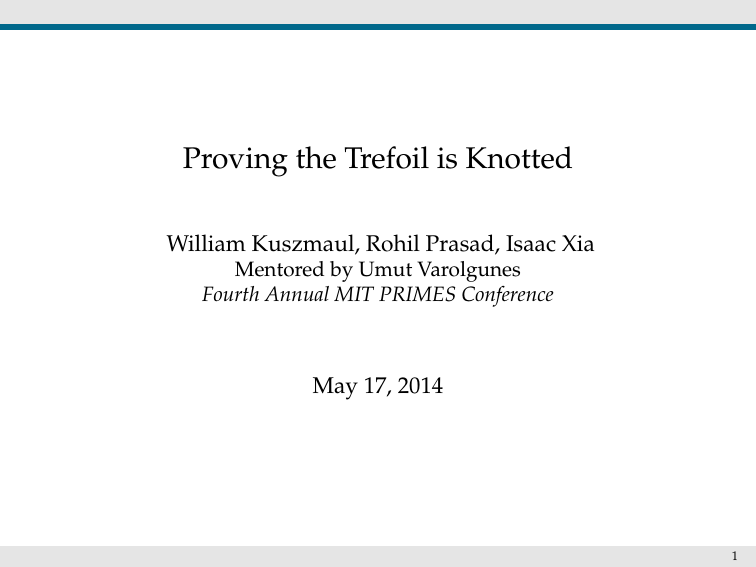
Proving the Trefoil is Knotted William Kuszmaul, Rohil Prasad, Isaac Xia Mentored by Umut Varolgunes Fourth Annual MIT PRIMES Conference May 17, 2014 1 H OW T O B UILD A K NOT 1. Take 1 piece of string 2. Tangle it up 3. Glue ends together 2 E XAMPLE K NOTS (a) Trefoil (b) 41 (c) 106 3 S OME KNOTS ARE THE SAME Knot diagrams can be deformed, like in real life. 4 R EIDEMEISTER M OVES I We think of knots as knot diagrams: 5 T HE BIG QUESTION Question: How can we show that two knots aren’t equal? Answer: Find an Invariant. Assign a number to each knot diagram so that two knot diagrams that are equivalent have same assigned number. 6 E XAMPLE I NVARIANT: C ROSSING N UMBER I Find an equivalent knot diagram with the fewest crossings I Crossing number = fewest number of crossings I But this is hard to compute in reality 7 A B ETTER I NVARIANT: T RICOLORING K NOTS I Assign one of three colors, a, b, c to each strand in a knot diagram (red, blue, green) I At any crossing, strands must either have all different or all same color I We are interested in the number of tricolorings of a knot. 8 W HY T RICOLORABILITY M ATTERS Theorem If a knot diagram has k tricolorings, then all equivalent knot diagrams have k tricolorings. How to Prove: Show number of tricolorings is maintained by Reidemeister moves. 9 E XAMPLE : B IJECTING T RICOLORINGS F OR S ECOND R EIDEMEISTER M OVE Case 1: Same Color 10 E XAMPLE : B IJECTING T RICOLORINGS F OR S ECOND R EIDEMEISTER M OVE Case 2: Different Colors 11 T REFOIL IS K NOTTED ! (a) 3 Unknot Tricolorings (b) 9 Trefoil Tricolorings =⇒ Trefoil6=Unknot 12 A D IFFERENT A PPROACH : F OCUS ON O NE C ROSSING Trefoil Knot (a) Crossing Change 1 (b) Crossing Change 2 How can we take advantage of this? 13 A W EIRD P OLYNOMIAL : J ONES P OLYNOMIAL J(K) 1. Pick a crossing: 2. Look at its rearrangements: (a) K1 (b) K2 (c) K3 3. Use recursion: t−2 J(K1 ) − t2 J(K2 ) = (t − t−1 )J(K3 ) J(O) = 1 14 W HY J ONES P OLYNOMIAL M ATTERS : I T ’ S AN I NVARIANT ! Theorem If knot diagrams A and B are equivalent, then J(A) = J(B). How to Prove: Show Jones Polynomial is unchanged by Reidemeister Moves. 15 E XAMPLE : 2 U NKNOTS AT O NCE (a) A1 (b) A2 (c) A3 (2 Unknots) J(2 Unknots) = J(A3 ) t−2 J(A1 ) − t2 J(A2 ) t − t−1 −2 t J(Unknot) − t2 J(Unknot) = t − t−1 −2 2 t (1) − t (1) = t − t−1 = = −t − t−1 . 16 A W EIRDER E XAMPLE : L INKED U NKNOTS (a) (Linked Unknots) B1 (b) B2 (c) B3 J(Linked Unknots) = J(B1 ) = t4 J(B2 ) + (t3 − t)J(B3 ) = t4 J(Separate Unknots) + (t3 − t)J(Unknot) = t4 (−t − t−1 ) + (t3 − t)(1) = −t5 − t. 17 J ONES P OLYNOMIAL OF T REFOIL (a) T1 (Trefoil) (b) T2 (c) T3 J(Trefoil) = J(T1 ) = t4 J(T2 ) + (t3 − t)J(T3 ) = t4 J(Unknot) + (t3 − t)J(Linked Unknots) = t4 (1) + (t3 − t)(−t5 − t) = −t8 + t6 + t2 . 18 C OMPLETING S ECOND P ROOF =⇒ Trefoil6=Unknot 19 A CKNOWLEDGEMENTS We want to thank 1. Our mentor Umut Varolgunes for working with us every week. 2. MIT PRIMES for setting up such a fun reading group. 20



